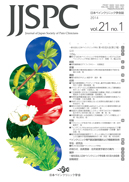Volume 22, Issue 4
Displaying 1-19 of 19 articles from this issue
- |<
- <
- 1
- >
- >|
-
2015 Volume 22 Issue 4 Pages 495-497
Published: 2015
Released on J-STAGE: November 07, 2015
Advance online publication: August 07, 2015Download PDF (190K) -
2015 Volume 22 Issue 4 Pages 498-506
Published: 2015
Released on J-STAGE: November 07, 2015
Download PDF (304K) -
2015 Volume 22 Issue 4 Pages 507-512
Published: 2015
Released on J-STAGE: November 07, 2015
Download PDF (469K)
-
2015 Volume 22 Issue 4 Pages 513-520
Published: 2015
Released on J-STAGE: November 07, 2015
Advance online publication: September 25, 2015Download PDF (549K)
-
2015 Volume 22 Issue 4 Pages 521-524
Published: 2015
Released on J-STAGE: November 07, 2015
Advance online publication: August 07, 2015Download PDF (193K)
-
2015 Volume 22 Issue 4 Pages 525-528
Published: 2015
Released on J-STAGE: November 07, 2015
Advance online publication: August 07, 2015Download PDF (203K) -
2015 Volume 22 Issue 4 Pages 529-532
Published: 2015
Released on J-STAGE: November 07, 2015
Advance online publication: August 07, 2015Download PDF (217K) -
Frequent hypoglycemia after prescription of pregabalin in a patient with painful diabetic neuropathy2015 Volume 22 Issue 4 Pages 533-536
Published: 2015
Released on J-STAGE: November 07, 2015
Advance online publication: September 25, 2015Download PDF (294K) -
2015 Volume 22 Issue 4 Pages 537-540
Published: 2015
Released on J-STAGE: November 07, 2015
Advance online publication: September 25, 2015Download PDF (471K) -
2015 Volume 22 Issue 4 Pages 541-544
Published: 2015
Released on J-STAGE: November 07, 2015
Advance online publication: September 25, 2015Download PDF (220K) -
2015 Volume 22 Issue 4 Pages 545-548
Published: 2015
Released on J-STAGE: November 07, 2015
Advance online publication: September 25, 2015Download PDF (310K) -
2015 Volume 22 Issue 4 Pages 549-552
Published: 2015
Released on J-STAGE: November 07, 2015
Advance online publication: September 25, 2015Download PDF (469K) -
2015 Volume 22 Issue 4 Pages 553-557
Published: 2015
Released on J-STAGE: November 07, 2015
Advance online publication: September 25, 2015Download PDF (258K) -
2015 Volume 22 Issue 4 Pages 558-561
Published: 2015
Released on J-STAGE: November 07, 2015
Download PDF (377K)
-
2015 Volume 22 Issue 4 Pages 562-563
Published: 2015
Released on J-STAGE: November 07, 2015
Advance online publication: August 07, 2015Download PDF (165K) -
2015 Volume 22 Issue 4 Pages 564-565
Published: 2015
Released on J-STAGE: November 07, 2015
Advance online publication: September 25, 2015Download PDF (265K)
-
2015 Volume 22 Issue 4 Pages 566-575
Published: 2015
Released on J-STAGE: November 07, 2015
Download PDF (544K) -
2015 Volume 22 Issue 4 Pages 576-585
Published: 2015
Released on J-STAGE: November 07, 2015
Download PDF (514K) -
2015 Volume 22 Issue 4 Pages 586-592
Published: 2015
Released on J-STAGE: November 07, 2015
Download PDF (440K)
- |<
- <
- 1
- >
- >|
